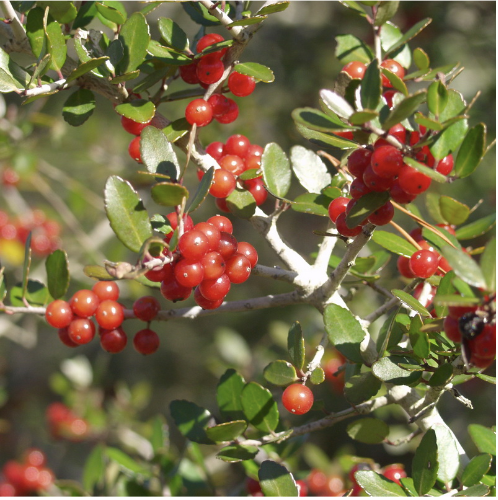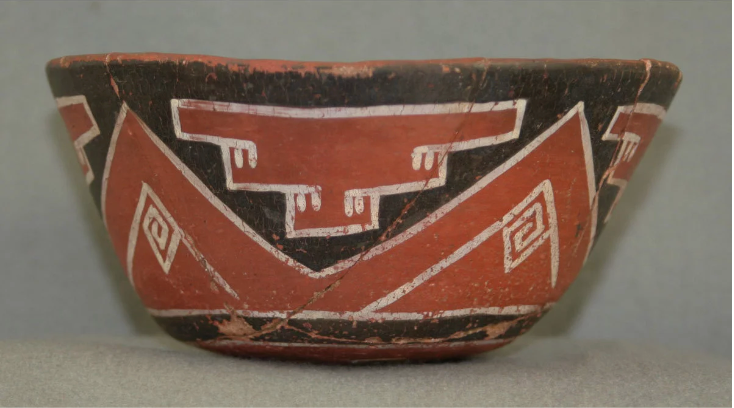Although caffeine consumption in America is generally associated with the post-industrial world, its origins lie in Native American societies more than 900 years ago. For example, people living in Cahokia – the largest pre-Columbian city north of Mexico – frequently consumed a caffeinated brew made from the roasted leaves of the yaupon holly, a plant containing caffeine (figure 1). This dark tea, later coined “Black Drink” by European explorers, became central to Cahokian purification rituals. As noted by Euroamerican observers, these practices sought to purify the body before important events such as individual or community religious rituals, important political councils and negotiations, ball games, and war parties. (Crown et al. 2012).

Yaupon holly has a caffeine content as high as six times that of strong coffee, causing it to induce sweating. When consumed in high quantities in rapid succession, it can even lead to vomiting. As part of the purification rituals, men would likely sit in circles, sing or chant, and take turns chugging Black Drink from cups made of marine shells and vomiting. In fact, the historical use of yaupon holly to vomit is what has given it its scientific name to this day: Ilex vomitoria (Richmond 2018).
Interestingly, Black Drink connects to our discussion of Cahokians’ interconnectedness with other Native peoples, as the holly trees from which the leaves were taken are found in the Coastal Plain of the southeastern US from Virginia to Florida and west to Texas (Crown et al. 2012). Thus, these trees were hundreds of miles away from Cahokia, requiring complex systems of trade to transport their leaves – a “level of political organization not before seen in North America” (Yates 2012).
However, this practice of long distance trade wasn’t unique to the Cahokians, as various other Native American civilizations also procured holly leaves via trade, likely using them for ritualistic purposes as well. An expert in the Chaco Canyon, archaeologist Patricia Crown led a team that analyzed 177 pottery samples from 18 sites across the American Southwest and Mexico. They found caffeine residue on pieces of jars, pitchers and mugs – such as the drinking vessel shown in figure 2 – in 40 samples from 12 sites and concluded that the groups likely consumed stimulant drinks in communal, ritual gatherings (Carpenter 2015). The fact that Black Drink was not just consumed by American Southwesterners and Cahokians, but also that both groups show signs of using it ritualistically tells of a remarkably interconnected pre-Columbian North America. Perhaps along intertwining trade routes such cultural practices as purification rituals were exchanged, creating the interconnectedness that the widespread use of holly leaves suggests.

References:
- Crown, Patricia L., Thomas E. Emerson, Jiyan Gu, W. Jeffrey Hurst, Timothy R. Pauketat, and Timothy Ward. “Ritual Black Drink Consumption at Cahokia.” Proceedings of the National Academy of Sciences 109, no. 35 (2012): 13944–49. https://doi.org/10.1073/pnas.1208404109.
- Richmond, Ben. “The Forgotten Drink That Caffeinated North America for Centuries.” Atlas Obscura, January 9, 2020. https://www.atlasobscura.com/articles/what-is-yaupon-tea-cassina.
- Yates, Diana. “Researchers Find Evidence of Ritual Use of ‘black Drink’ at Cahokia.” Illinois, August 6, 2012. https://news.illinois.edu/view/6367/205015.
- Carpenter, Murray. “1,000 Years Ago, Caffeinated Drinks Had Native Americans Buzzing.” NPR, September 8, 2015. https://www.npr.org/sections/thesalt/2015/09/08/437580856/1-000-years-ago-caffeinated-drinks-had-native-americans-buzzing.

What are some common challenges that archaeologists encountered when examining caffeine residue in containers? What solution was applied to tackle these issues, and what does this tell us about the development of archaeology?
In 1976, archaeologist Charles Hudson identified this challenge, writing in Black Drink: A Native American Tea that “[t]he act of brewing and drinking a beverage does not leave any trace in the earth which can be discovered by an archaeologist.” At the time, absorbed pottery residue analysis was in its infancy, however the development of gas chromatography/mass spectrometry (GC/MS) has since allowed archaeologists to deduce what we now know about ritualistic caffeine consumption from pottery residue.